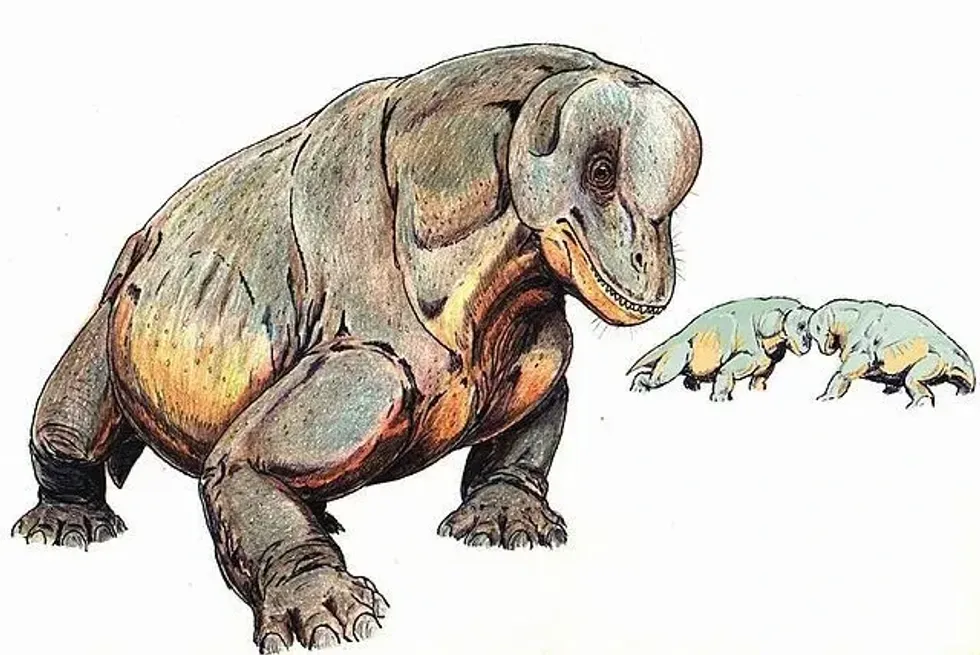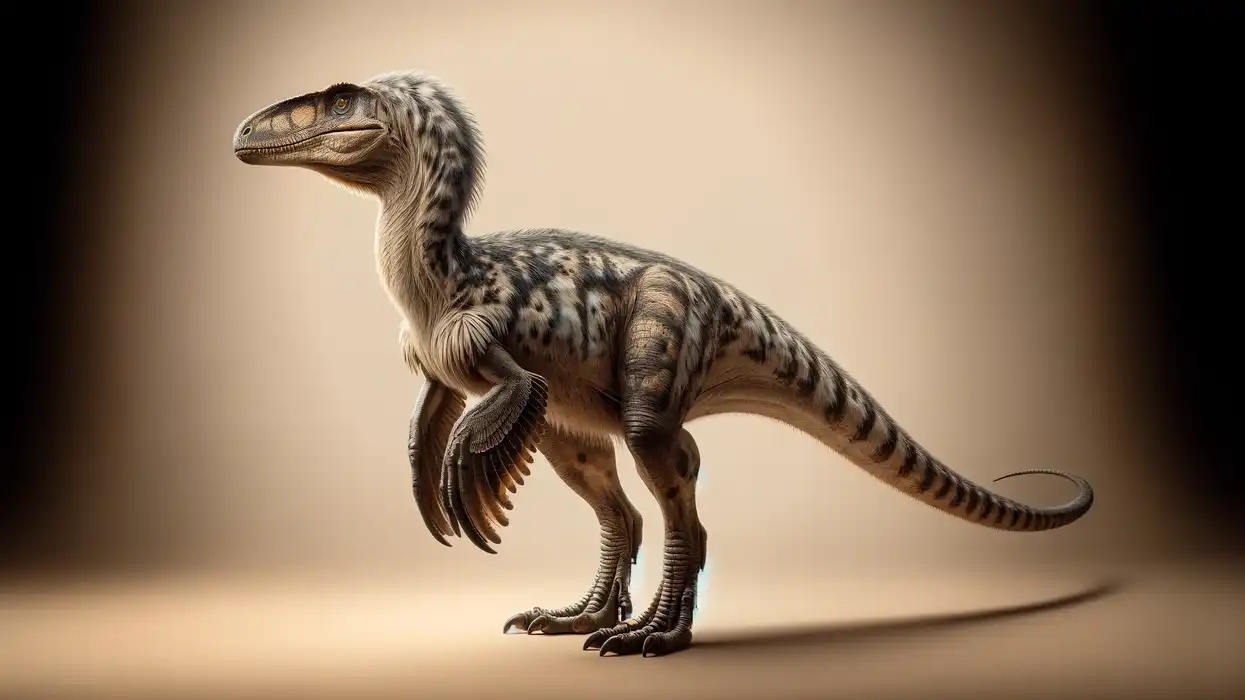Tapinocephalus is an ancient animal that is known to have been ancestors to dinosaurs. Many a geological society and paleontological society have estimated that this animal lived during the Middle Permian age, around 251 million years ago!
Fossil remains of the Tapinocephalus have been found in the South African Karoo Basin to such an extent that the formation has been named the Tapinocephalus Assemblage Zone.
For more related content, check out Paleosaurus facts and Ornithosuchus facts!
Tapinocephalus Interesting Facts
Was the Tapinocephalus a dinosaur?
The Tapinocephalus was a genus of animals that existed long before dinosaurs came into being. They are therefore classified under Dinocephalia. Dinocephalians, unlike dinosaurs of natural history, were both viviparous and oviparous - which is one of the many differences in the suborders.
How do you pronounce 'Tapinocephalus'?
The name of this animal would be pronounced as 'ta-pee-no-say-phallus'.
What type of prehistoric animal was a Tapinocephalus?
Tapinocephalus was a dinocephalian genus of the Therapsida clade. The fossils of this animal suggest that the skull roof had a bony structure that would also serve the animal in head-butting.
In which geological period did the Tapinocephalus live?
The geological period during which the Tapinocephalus could have been seen treading the surface of the earth was the middle Permian period. If you happen to be wondering how long ago that would be, you will definitely be astounded to know that these animals lived no less than 299-251 million years ago!
As you can already tell, these animals of middle Permian South Africa were were part of a much older period than what we recognize most dinosaurs to have belonged to.
When did the Tapinocephalus become extinct?
The exact timeline as to when the Tapinocephalus (Therapsida, Dinocephalia) may have become extinct is not known completely, however, we do know that the middle Permian age in South Africa came to an end around 251 million years ago.
If these animals managed to live through to the end of the geological period, it is likely that this figure would give us a rough estimate of the time of their extinction.
Where did a Tapinocephalus live?
The habitat of a Tapinocephalus can easily be understood to have consisted of low-lying plants in a woodland or forest. Being an animal of considerably small height, these animals would prefer living in the proximity of lower-lying vegetation, due to their herbivorous diet.
What was a Tapinocephalus's habitat?
The fossils of this therapsid animal of the middle Permian period have been found in the South African Karoo Basin. The extent to which this area is rich in Tapinocephalus fossils is such that it is called the Tapinocephalus Assemblage Zone (Capitanian age).
These fossil remains have been recovered from the upper, lower, and middle parts of the Tapinocephalus zone, which tells us that these animals may have thrived in large numbers. The specific formation where they were discovered is known as the Lower Beaufort Beds.
Since the fossils have only been found in the Tapinocephaus Assemblage Zone (Capitanian age) of the Lower Beaufort beds in the South African Karoo Basin, it may be assumed that these tapinocephalid dinocephalians may have been endemic to this area.
Who did a Tapinocephalus live with?
The society of the Tapinocephalus is estimated to have consisted of other herbivores of the area such as Moschops capensis and other related species. Being herbivorous members of Therapsida Dinocephalia, the Tapinocephalus atherstonei would like to not only live in the society of other related species but would also like to engage in activities involving head-butting.
How long did a Tapinocephalus live?
The average lifespan of the Tapinocephalus is not known to us, since the fossil remains that have been discovered from the Lower Beaufort Beds of the middle Permian of South Africa do not give us enough insight into such facts.
How did they reproduce?
The exact mode of reproduction undertaken by these ancient animals is not clear, and since dinocephalians of the Beaufort Formation are known to have been both viviparous and oviparous, it would hardly be fair to take a guess.
Although, a bit of information that the geological society of London gives us regarding the courting habits of these animals includes the fact that they would also perform head-butting in order to mate!
Tapinocephalus Fun Facts
What did a Tapinocephalus look like?
 We've been unable to source an image of Tapinocephalus and have used an image of Moschops instead. If you are able to provide us with a royalty-free image of Tapinocephalus, we would be happy to credit you. Please contact us at hello@kidadl.com.
We've been unable to source an image of Tapinocephalus and have used an image of Moschops instead. If you are able to provide us with a royalty-free image of Tapinocephalus, we would be happy to credit you. Please contact us at hello@kidadl.com. The most typifying feature of this tapinocephalid animal is its skull roof. It is also characterized by a bony and bulky body, a skull that would show lots of folds and bumps, and a short height.
How many bones did a Tapinocephalus have?
The exact number of bones that there were in the body of a Tapinocephalus is yet to be understood since the complete skeleton of the animal has not been found - in spite of how rich the Tapinocephalus Assemblage Zone is in terms of fossil remains.
This also leads to a lot of speculation regarding the characteristics of the Tapinocephalus atherstonei species.
How did they communicate?
The mode of communication used by these animals is not clear to us. However, the cranial structure and the bony roof of their skull suggest that head-butting would have served as a preliminary means of communication between the individuals of the community.
How big was a Tapinocephalus?
The average Tapinocephalus is estimated to have been around 10 ft (3 m) in length. The height of this animal (Synapsida, Therapsida), however, is yet to have been estimated.
How fast could a Tapinocephalus move?
The average speed at which the Tapinocephalus atherstonei could run has not been estimated because there are hardly any fossil remains of the limbs of this animal have been found from the Lower Beaufort Beds in the Tapinocephalus Assemblage Zone.
However, the bulky build of these animals of present-day South Africa does tell us that they might have not been the fastest when it came to running.
How much did a Tapinocephalus weigh?
The average weight of a Tapinocephalus atherstonei is estimated to have been around 3300-4400 lb (1500-2000 kg).
What were the male and female names of the species?
Since there are no distinct names for the two sexes of the Tapinocephalus, we have resorted to simply referring to them as the male Tapinocephalus and female Tapinocephalus respectively.
It is also interesting to note that the fossil remains of this animal do not show any morphological difference that may have existed between the two sexes.
What would you call a baby Tapinocephalus?
Since the mode of reproduction used by these animals is not clearly known as yet, there can hardly be any conclusive name given to the juvenile Tapinocephalus. We have therefore decided to refer to it as a baby or a young Tapinocephalus.
What did they eat?
This animal genus is known to have been herbivorous, which means that it would feed on plants and other soft foliage that was abundant during the middle Permian period. The genus also shows the typifying characteristics of the clade Synapsida, Therapsida, and Dinocephalia sub-order.
How aggressive were they?
It is unlikely that the Tapinocephalus genus of animals would have been aggressive since they are estimated to have been small, herbivorous animals of the upper, middle, and lower Tapinocephalus Zone in South Africa.
Although the skull and the bony roof on top of it may give away a different impression, the history of animals and their relative behavior tells us that this animal could not have been dangerous.
Did you know...
The skull and cranial structure of the Tapinocephalus atherstonei are almost the same as Moschops capensis.
What does the term Tapinocephalus mean?
The name Tapinocephalus literally translates to 'humble head'. This refers to the cranial structure of the genus and the bony skull roof that characterizes the genus as a whole!
Was Tapinocephalus endemic?
It is assumed that the Tapinocephalus would have been endemic to present-day South Africa.
The fossil remains of this animal have been found in the upper, middle, and lower Tapinocephalus Assemblage Zone, which tells us the extent to which the animal thrived in the area, however, since fossil remains are yet to be found in any part of the world other than South Africa, paleontologists assume this genus to have been endemic to the land.
Here at Kidadl, we have carefully created lots of interesting family-friendly prehistoric animal facts for everyone to discover! Learn more about some other creatures from our Sivatherium facts, or Diplocaulus fun facts for kids pages.
You can even occupy yourself at home by coloring in one of our free printable Tapinocephalus coloring pages.










